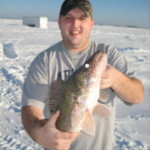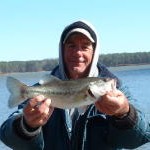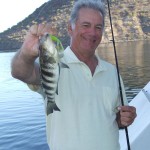Three Structures To Target for Bass This Winter
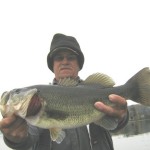
This bass was caught in the winter at Lake Guntersville
By Scott Suggs
If we’re going to be honest about it, fishing in the winter isn’t always the most pleasant activity. It can be cold, windy and sometimes getting the fish to cooperate can be frustrating. But just because the calendar has been flipped to December doesn’t mean that you should park the boat and resign yourself to hanging lights and watching football.
Catching fish in the winter requires some knowledge about the body of water that you are fishing and a decided amount of patience. Slowing down your presentations will go a long way towards ensuring you get more than a runny nose for your time on the lake. So before you head out for your next day of fishing, try focusing on these three types of structure.
Bluffs]
A lot of tournaments are won year round on rock bluffs. Big smallmouth and largemouth both like to hang on these bluff ledges during this time of year. But enticing strikes from finicky bass in winter can be a challenge. Fish each spot slowly and don’t limit yourself to just one lure or technique. In clear water, natural colored worms can be very effective for a smallmouth bite. A Berkley PowerBait Hand Pour Finesse Worm fished on a dropshot rig that is worked slowly on the ledges works extremely well.
But don’t forget that crayfish also inhabit these rock bluffs and a big jig tipped with a PowerBait Chigger Craw will also work. Just keep the retrieve slow. Lipless crankbaits like a Frenzy Rattl’r fished parallel to the bluffs is also can entice strikes, but be careful that your retrieve isn’t too fast. Also remember that shad and other baitfish swim these bluffs during winter so a Berkley Gulp! Jerk Shad Texas rigged with a wide-gap hook and swimmed through the desired depth can result in a lot of hook ups.
Main-lake points
Main-lake points hold bass pretty much year round. But during winter, when the lake is low, they really start to bunch up on these structures. Find a point that is just out of the swift, main lake current and there is likely to be a bunch of bass feeding on baitfish and crayfish. If there is deep water nearby, that deeper water is likely to hold bass, too.
These out-of-the current spots can hold huge schools of bass, bunched up, usually in one very small spot. This means either dragging bottom-bumping lures, or fan casting, Carolina-rigged lures like a PowerBait Power Lizard or a Gulp! Turtleback Worm and looking for that instinct strike. Wood cover along these spots always harbor the bigger largemouth’s in the area. Try laydowns, washed in debris, stumps and brush piles and go after them with a jig and trailer.
Humps
Smallmouth bass and a surprisingly good number of largemouths, can both be found around islands, submerged humps, sand bars and ridges, located throughout lakes. Because of low water levels in winter, many are now visible; others can be found by paying attention to your electronics. Smallmouth relate to the edge of the swift current, waiting for an easy meal. Largemouth tend to hug the bottom and hang out in the cover (stumps, ledges).
Fishing these areas can be tough when the weather is extremely cold, but slowly down and finesse are of the utmost importance whenever fishing these areas. Dropshotting small, straight-tailed finesse worms like the PowerBait Hand Pour Finesse Worm or Carolina rigging small, finesse lures, such as worms, lizards, grubs, jerkbaits and crayfish imitations, will entice more strikes in very cold water than baits with a larger profile. Lighter line also works better in these situations, so make sure your spinning reel is in good working order.
Don’t let a little cold keep you off the lake this winter. There’s a lot less boat traffic this time of year and still a lot of fish to be caught. Just make sure to slow down your presentation and downsize your line and focus your attention on these three wintertime hotspots and pretty soon everyone will want to go with you.
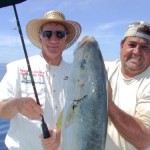 La Paz and Las Arenas Fishing Report – Fishing in the Sea of Cortez
La Paz and Las Arenas Fishing Report – Fishing in the Sea of Cortez